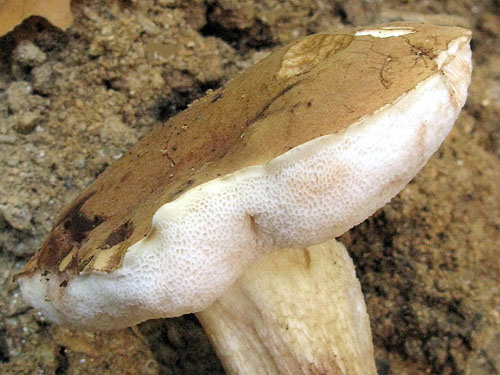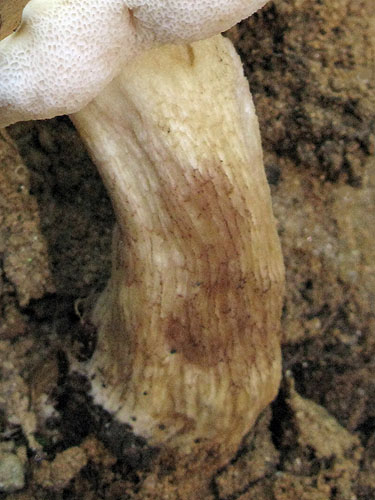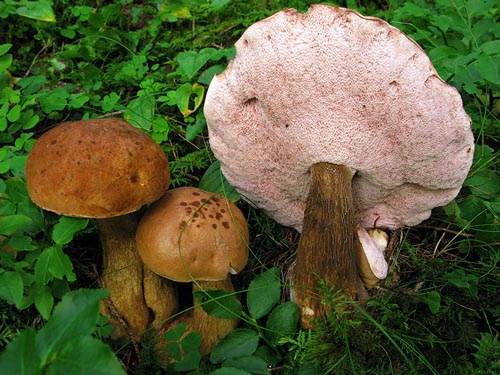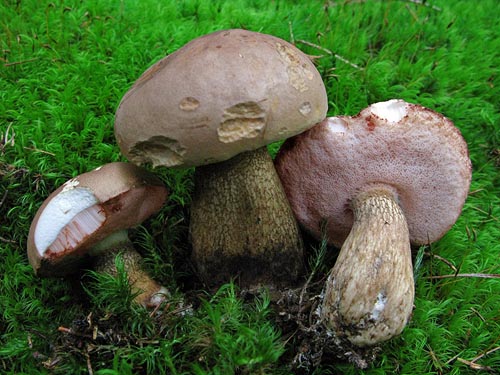Tylopilus P. Karst.
The only European member of this genus is instantly recognized due to its pinkish pores, bitter flesh and pink spore-print.
Tylopilus felleus (Bull. : Fr.) P. Karst.
Description
Cap up to 12 cm, at first hemispherical then expanding to convex, sienna, beige, pale brown, at first velvety, then glabrous. Stipe club-shaped or sometimes cylindrical, almost concolorous with the cap, often paler in the lower part, covered with well developed brown reticulum. Flesh white or cream, unchanging when exposed to air. Tubes at first whitish, then pale pinkish. Pores whitish, then pale pinkish. Smell not distinctive. Taste bitter. Spores 11–17.5 × 3–5 μm.
Habitat. Coniferous, mixed and deciduous forests, mycorrhizal with both coniferous and broadleaf trees.
Distribution. Widespread throughout Europe.
Similarity. Sometimes confused with Boletus edulis, but recognized by the pinkish tint of the pores and the bitter flesh.
Photographs

Fruitbody of Tylopilus felleus. (photo I. Assyova)

Tylopilus felleus - detail of the pores. Note the pale pinkish tint of the pores that is characteristic for this bolete. (photo I. Assyova)

Tylopilus felleus - stipe surface. Note the fine network. (photo I. Assyova)

Mature fruitbodies of Tylopilus felleus with the typical prominent pink colouration of the tubes. (photo A. Akulov)

Fruitbodies of Tylopilus felleus. (photo G. Konstantinidis)

Fruitbodies of Tylopilus felleus. (photo G. Konstantinidis)

Bulliard's painting accompanying the original description of Boletus felleus (= Tylopilus felleus)

Spores of Tylopilus felleus. (photo G. Konstantinidis)
Important literature
Alessio, C.L. 1985. Boletus Dill. ex L. (sensu lato). – In: Fungi Europaei. Vol. 2. Pp. 1–705. Libreria editrice Biella Giovanna, Saronno.
Breitenbach J. & Kränzlin F. 1991. Pilze der Schweiz. Bd. 3(1). Röhrlinge und Blätterpilze. Verlag Mykologia, Luzern.
Estadès, A. & Lannoy, G. 2004. Les bolets européens. – Bulletin Mycologique et Botanique Dauphiné-Savoie 44(3): 3–79.
Galli, R. 1998. I Boleti. Atlante pratico-monographico per la determinazione dei boleti. Edinatura, Milano.
Hansen, L. & Knudsen, H. 1992. Nordic Macromycetes. Vol. 2. Polyporales, Boletales, Agaricales, Russulales. Nordsvamp, Copenhagen.
Knudsen, H. & Vesterholt, J. [eds.]. 2008. Funga Nordica. Nordsvamp, Kopenhagen.
Lannoy, G. & Estadès, A. 2001. Les Bolets. Flore mycologique d’Europe. Documents Mycologiques Mémoire Hors série no. 6. Pp. 1–163. Association d’Écologie et de Mycologie, Lille.
Muñoz, J.A. 2005. Boletus s. l. – In: Fungi Europaei. Vol. 1. Pp. 1–951. Edizioni Candusso, Alassio.
Pilát, A. & Dermek, A. 1974. Hríbovité huby. Československé hríbovité a sliziakovité huby (Boletaceae – Gomphidiaceae). Veda, Bratislava.
Singer, R. 1967. Die Röhrlinge. II. Die Boletoideae und Strobilomycetaceae. – In: Die Pilze Mitteleuropas. Vol. 6. Pp. 1–151. Julius Klinkhardt Verlag, Bad Heilbrunn.
Šutara, J., Mikšík, M. & Janda, V. 2009. Hřibovité houby. Čeled’ Boletaceae a rody Gyrodon, Gyroporus, Boletinus a Suillus. Academia, Praha.
Watling, R. 1970. Boletaceae, Gomphidiaceae, Paxillaceae. – In: Henderson, D.M., Orton, P.D. & Watling, R. [eds]. British fungus flora. Agarics and Boleti. Vol. 1. Royal Botanic Garden, Edinburgh.
Watling, R. & Hills, A.E. 2005. Boletes and their allies (revised and enlarged edition). – In: Henderson, D.M., Orton, P.D. & Watling, R. [eds]. British Fungus Flora. Agarics and boleti. Vol. 1. Royal Botanic Garden, Edinburgh.